The gang of 5 chicks born March 25 are nearly a month old and spending more time away from their mother. This afternoon I found them resting together, their mother happily feeding by herself.
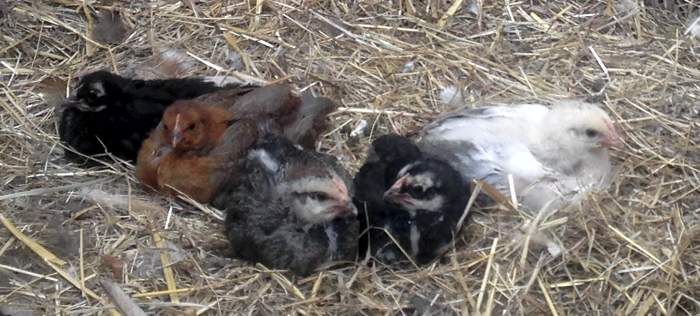

While these one day chicks, born on Easter, are getting their first taste of life outside the nest. They have a very feisty mother. In fact the most protective hen I’ve seen. It will be interesting what sort of mother she turns out to be. The variety of personalities even among hens is remarkable. Here at a man and his hoe®, the chickens have the space and freedom to let their personalities bloom.
First Post Child Rearing Egg
Hens lay special eggs at times. There is the very first egg they lay, which is a tiny egg. There is the first egg they lay after their winter lull. These eggs also tend to be smaller. And then there is the first egg they lay after raising chicks. And today this mother laid her first egg after raising chicks for three weeks. That is on the early side. Most hens take more than a month before they go back to laying eggs.
I get the sense that this mother may not be raising her chicks much longer. They are getting very independent and at times during the day they stray tens of feet from her. When she was up on the nest laying her egg, her five chicks huddled together and waited patiently for her to come back down.

The Importance of Siblings
Next to a mother, siblings are the most important relationships young chickens have. When you go shopping for chicken and eggs, the fact that chickens develop such relationships probably doesn’t cross your mind. But chicks which are raised by their mother, develop strong attachment to their brothers and sisters. So, when their mother leaves them on their own, the siblings stick together. They roost together and roam together.
As they age, their sibling relationships get more complicated. The males and female chicks start to separate, with the males hanging out together, and the females sticking together. It’s only possible for chickens to have these sibling attachments where they are raised by their mothers and have plenty of space to be themselves.
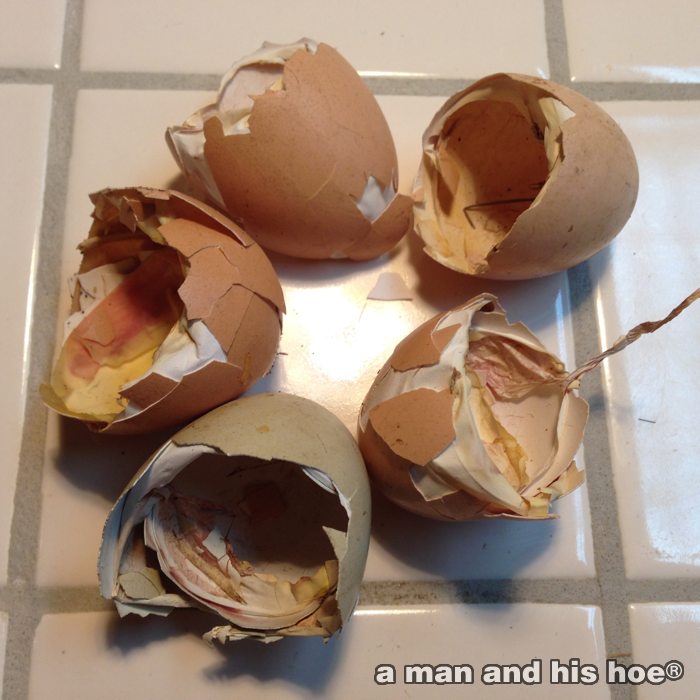
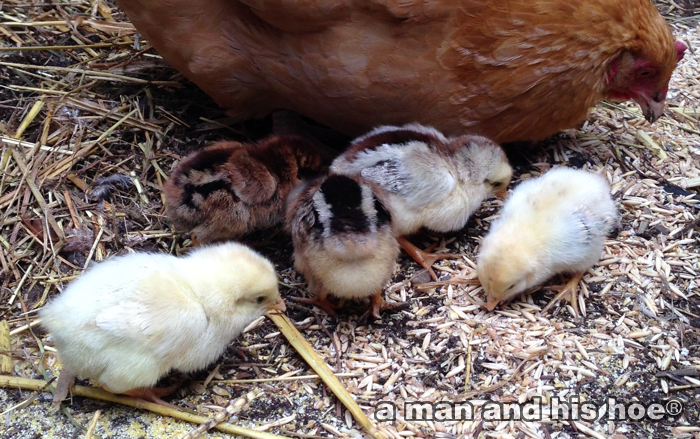



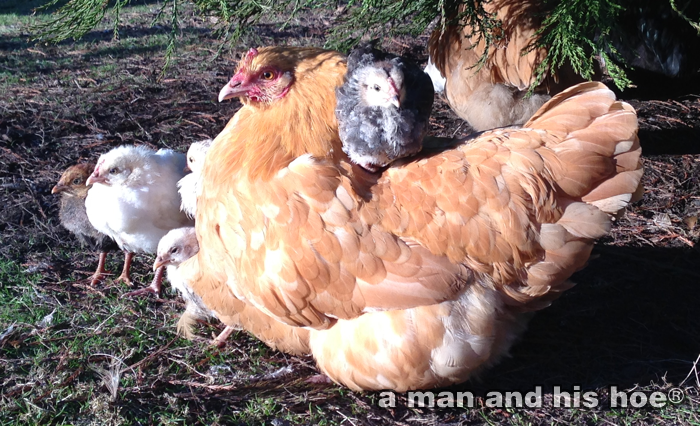
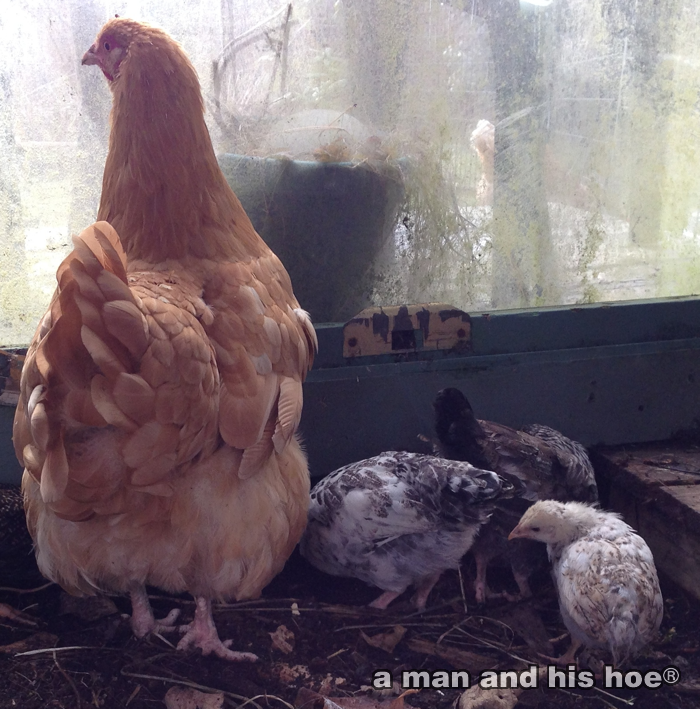

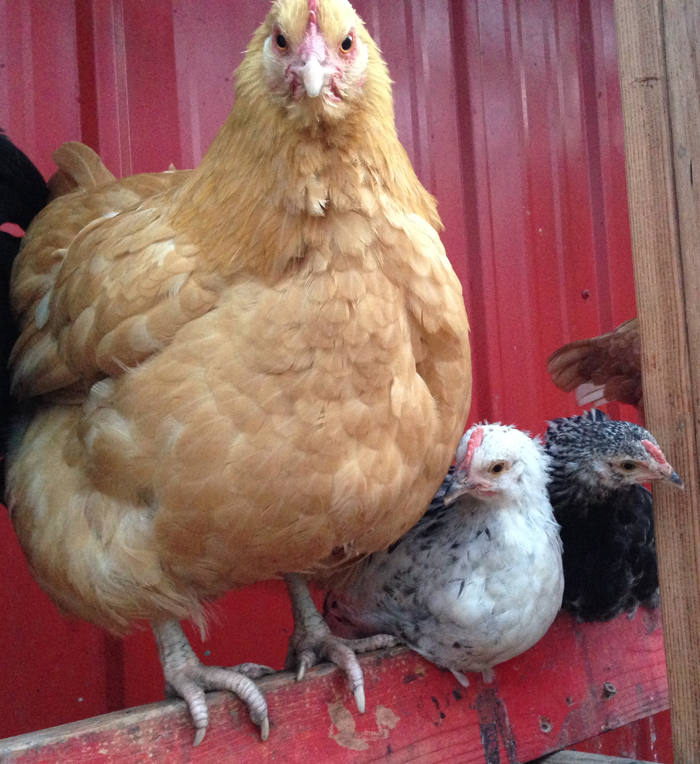


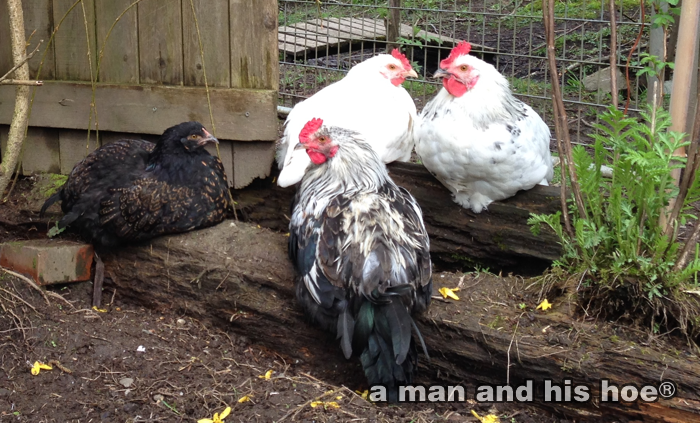

Chicken Love – Blink and It’s Over
Ten seconds. That’s usually all it takes. When there is no chase, knock off five seconds. But the rooster doesn’t get the hen every time. Sometimes she out runs him. Sometimes another rooster steps in the way. Sometimes another rooster will knock him off the hen. Sometimes another hen will chase him off. It is what it is.
What do hens say about human love? That it takes forever? That they’re stuck with the same man over and over again? That there’s no variety?
Chick Adventure in the Wild
[wpvideo 78Q3VVXI]
What a morning for these five day old chicks. When their mother tries to lure them through a stream, they panic. The water is too deep for them. Separated from her, the chicks chirp loudly, begging her to come back. One even falls into the stream, and valiantly struggles up the steep bank. Others clamber over a mountain of a bush to reach their mother.
After the wild and terrifying adventure for these chicks, they get a well deserved rest under their mother’s warm feathers.
I laugh when I read of those raising chicks in broilers talk about enrichment programs for their chicks. These enrichment programs consist of providing bales of hay, perches, and objects for the chicks to peck. They certainly don’t include outdoor adventures such as fording streams or trying to keep up with Mother as she forages through rangeland.
Why Chicks Deserve a Mother – Reason #2
[wpvideo 2kDUb7PB]
Another reason chicks deserve a mother is that with a mother, they get to go outside at a very early age. These chicks are just four days old and they are having the time of their lives scratching around outdoors with their mother. From now on, they will be spending most of their days outdoors. Farmers who raise their chicks without mothers would never consider putting such young chicks out to pasture. Most wait until the chicks are three, four or five weeks old before putting them outside. For example:
- Green Legacy Farms waits until their chicks are four weeks old.
- Jericho Settlers Farm keeps them indoors for three weeks.
- Stony Brook Farm puts them out to pasture after two, three or four weeks depending on the time of year.
- Earth Action Mentor waits three weeks, though if the weather isn’t too cold, they will put them out earlier.
What these farms are doing is understandable. Without a mother to guard and provide warmth as needed, putting chicks outside after just four days would be cruel, if not a death sentence. But with a mother watching over the chicks, going outdoors at just four days old, even in cool weather, is no problem. The earliest I’ve seen a hen take her chicks outdoors is at day two, and the latest at 14 days. Most of the hens have their chicks running around outdoors within a week of hatching.
Why Chicks Deserve a Mother – Reason #1
[wpvideo 3y9aTj4J]
Imelda is curious about the new chicks. The last few days, she’s spent a fair amount of time hanging out with the new mom and her chicks. Is she wanting to hatch eggs of her own? Does she think the chicks look good to eat? I don’t think so because she’s never shown any aggression toward the chicks. She just seems to enjoy hanging out with them.
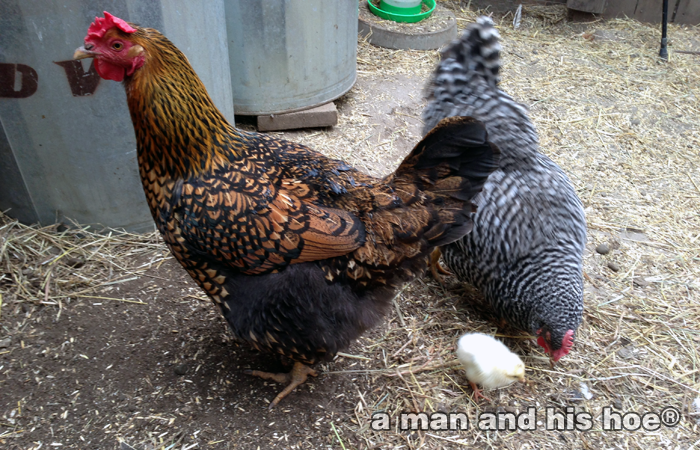
Another Dominique hen has gone broody. Today I prepped an incubation suite for her. She’s been sitting on two wooden eggs for the last two days. Tonight, when it is dark, I’ll move her into the incubation suite and put 10 to 12 eggs under her. Hopefully, in three weeks, I’ll have another clutch of chicks. Moving broody hens is risky. Some will take to the new nest without a hitch. Others will want to go back to the nest where they were brooding.
This is the first time I’ve made an incubation suite. It will give the brooding hen, a safe, quiet place to sit for three weeks without being disturbed by the other hens. Besides having a dark, spacious nest inside the barn, she’ll also have a small yard to eat, poop, and stretch her wings.

Often, when hens are incubating a clutch of eggs, other hens will insist on laying eggs in the same nest. Some hens stand their ground and won’t budge an inch. However, all brooding hens leave their nest at least once a day to eat and poop. During the twenty to thirty minutes they are off the nest, other hens can hop on the nest to lay an egg. If they are still on the nest when the brooding hen returns, chaos often erupts.
Hopefully, the incubation suite will solve these problems, and give the brooding hen a carefree brooding experience. If she wants to go outside and enjoy a sunbath, I can slide open the side for her and close it while she is out, to keep her eggs undisturbed. Perhaps I should think about temporarily placing a RFID tag on her and wire a door so it would open and shut only for her.
Which brings me to my ultimate dream device: a tiny automated stamping device I could implant in a hen’s vent so that every time she lays an egg, the egg would get a timestamp which includes the hen’s name and GPS coordinates. The device would also have a super fast DNA decoder which would instantly determine which rooster fertilized the egg and stamp his name on the egg as well. Or if the egg was not fertilized, it would note that too. And of course, the device would send a text message with all of this information. Then I would instantly know when and where each hen laid an egg.
A Very Safe Place
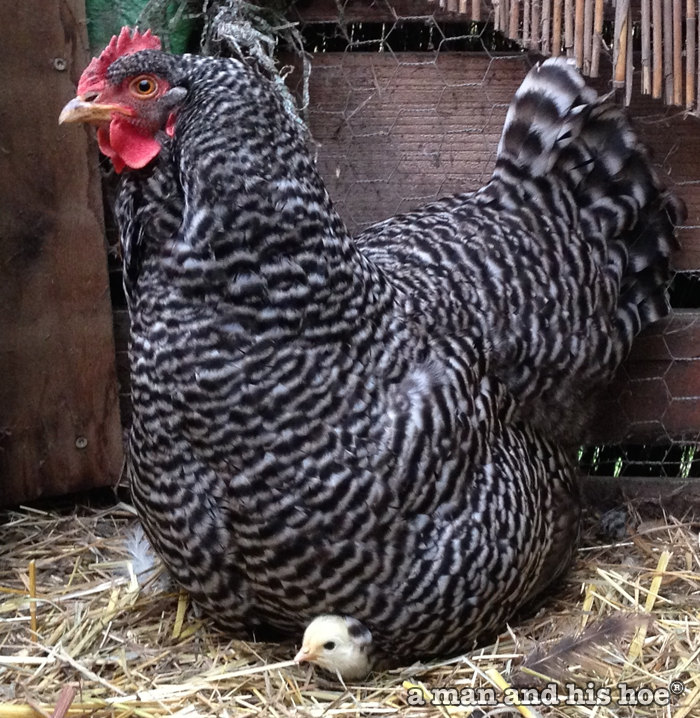
The wonderful thing about letting mothers raise chicks is that you don’t need to keep the chicks under heat lamps. Whenever the chicks need to warm up, they can duck under their mother’s warm feathers for a rest. The other four chicks are in there somewhere.
For a chick, being under a mother’s feathers is a very safe place from which to peek and check out the world.
The Lucky Ones
[wpvideo q93Wl6oJ]
This is a sure sign of spring, the first chicks of the year. They hatched yesterday, and this is their very first morning. These are the lucky ones. The tiny, nearly infinitesimal percentage of chicks born each year which develop in their eggs listening to their mother’s comforting heart beat, which hatch beneath their mother’s warm breasts, and grow up under her tender care.
According to the USDA, in January 2014, 717,153,000 chickens were slaughtered in the USA along, and in February 2014, the number was 675,901,000. None of those chickens had a mother. Neither do the tens of millions of hens which are raised each year by the egg laying business. When you buy my eggs, or my chicken, each one of them was hatched and raised by a caring mother.
Five Blossoms
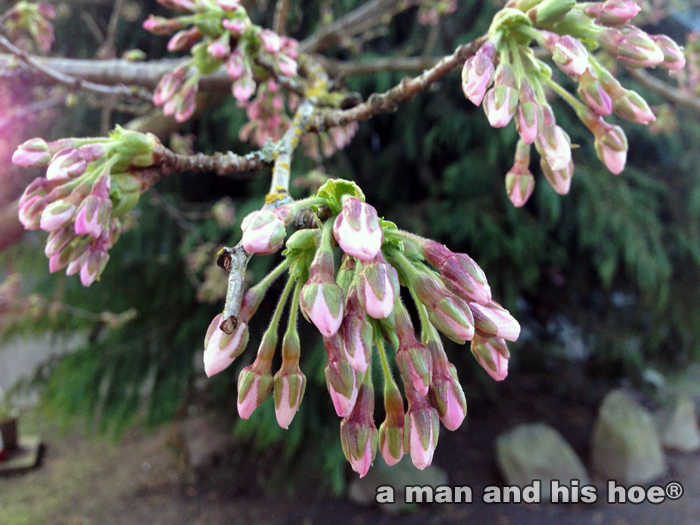
Five open blossoms is what it takes for the meteorologists in Japan to proclaim that the cherry blossoms have bloomed in a city. In each city, there is one tree which is declared the reference tree, and when five blossoms on that tree have opened, a declaration is made that the cherry trees have blossomed in that city. There are even reference trees in waiting, just in case the reference tree dies.
We had more than five open blossoms on our reference tree here at a man and his hoe®. So I declared yesterday that our cherry trees were in bloom. There are still many buds about to burst open. A few more sunny days, and our reference tree will be in full bloom.

Speaking of sunshine, chickens love sunshine. They can spend hours sunning themselves in the warm sunshine. You’ll see them turning on their sides and lifting their wings to really air out.
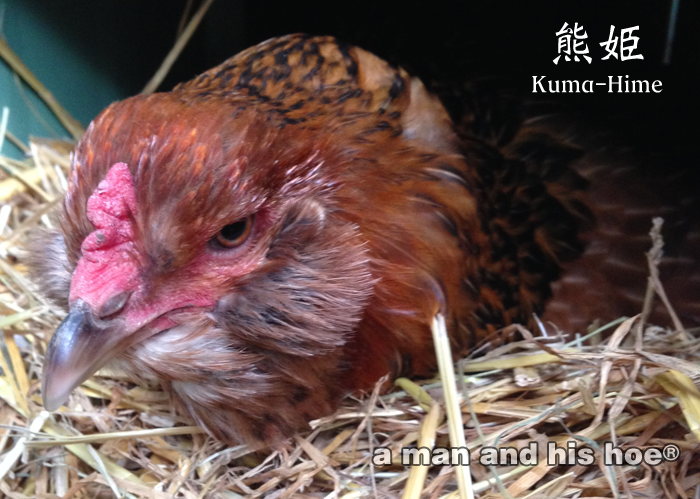
Dinosaur? Look closely into a chicken’s eyes, and it’s not difficult to see that birds are what dinosaurs evolved into. A chicken’s beak is a formidable weapon. It’s a good thing they are much smaller than us.

How long has that rock been there? The moss knows.

And what is this? A rooster sitting on a nest? I’ve read that roosters will sometimes sit on a nest to let hens know that they’ve found a good place to lay an egg. Sven spent more than an hour on this nest this morning. At times he even got up and clucked like a hen. He did entice one hen to sit on the nest, but she didn’t stay long enough to lay an egg. Maybe he’ll have better luck tomorrow.
